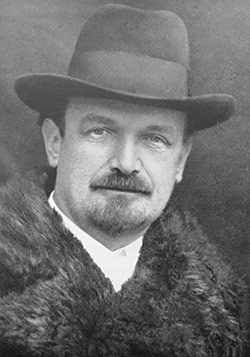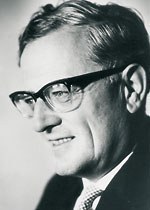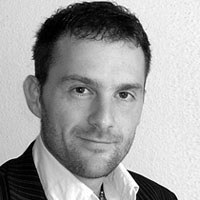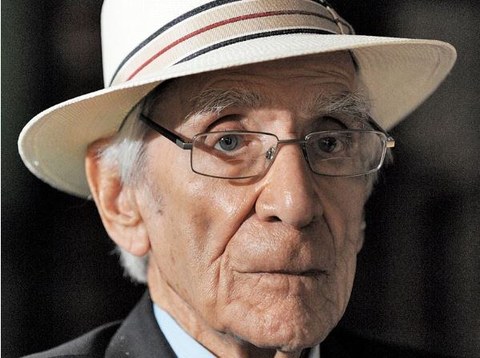Artists
Arnold Böcklin (1827-1901)
Böcklin (*19.10.1827 in Basel; 16.1.1901 in Fiesole, Toscana) is one of the most famous - and controversial - painters of his time. On his grave you can read the Quote from Horace:
Non omnis moriar (I shall not wholly die).
From 1835/6 to 1843/4 Böcklin attended the grammar school 'auf Burg' where he developed a close relationship to Antiquity. A great many of his pictures are centered on ancient themes or motives, although Böcklin rarely refers to specific literary models as Kalypso and Ulysses (1882, Basel). He often regretted not having studied Greek in addition to Latin in order to have a better linguistic and cultural basis for his paintings. Böcklin made his apprenticeship in Basel (with Ludwig Kelterborn), Düsseldorf and Paris and Jacob Burckhardt was his generous patron. Later he worked and lived partly in Rome, Munich, Zurich, and Florence / Fiesole. In addition to painter, Böcklin was also a Kind of flight pioneer: he designed and flew his own gliders although with very little success.
His paintings can be admired in many museums in Europe and the USA. Among his masterpieces are:
Diana's Hunting (1862, Basel)
Isle of the Dead (5 Versions, one of 1880 in Basel)
The sacred Grove (1882, Basel / 1886, Hamburg)
The game of the Naiads (1886, Basel)
The Island of life (1888, Basel)
Plague (1898, Basel, unfinished)
Portraits (e.g. Gottfried Keller, 1889, Zürich) and Self-portraits
He impressed and influenced a great number of painters (Edvard Munch, Lovis Corinth, Paula Modersohn-Becker, Giorgio de Chirico, even Salvador Dalí). Some of his paintings inspired composers to write symphonic poems (Sergei Rachmaninoff: Die Toteninsel, Max Reger: Vier Böcklinbilder). The "Böcklin fever" in the 19th century created important works of art. Reproductions of his paintings found their way into the living rooms until well into the 20th century. Max Lehrs believed in 1897 that Böcklin was to the 19th century what Leonardo, Dürer and Rembrandt had been to their centuries. Edvard Munch considered him a German (!) artist who equalled Wagner and Nietzsche in their fields of music and philosophy. But Böcklin got also a lot of criticism because on the one hand, his Pictures were fascinating but at the same time they were also shocking. In Theodor Fontane's novel "Stechlin", one of the characters describes Böcklin as a hybrid of envy and tastelessness. The People of Basel, though, were proud of "their ingenious fellow citizen" and celebrated his birthdays publicly. The town's art commission bought (albeit sometimes after much hesitation because of the Prices) his pictures for the museum. But they were also in a constant Dispute with the artist which drove him temporarily from away Basel - even to Zurich!
As a consequence of Julius Meier-Graefe's book 'The Böcklin case' of 1905, the master's popularity began to decline. Although today he is considered a significant painter of the 19th century he doesn't attract streams of visitors, as his contemporaries, the French Impressionists, do.
Christoph Delz (1950-1993)
Attended the Humanistisches Gymnasium fron 1966 to 1972, pianist and composer.
Christoph Delz was the son of Josef Delz, teacher of Latin and Greek at the Humanistisches Gymnasium Basel and later Professor of Latin at the Universities of Berlin and Basel. Before he graduated at the HG, Christoph obtained the teaching as well as the concert diploma for piano. He completed his studies from 1974 to 1981 in Cologne (piano with Aloys Kontarsky, composition with Karlheinz Stockhausen) and Liège (composition with Henri Pousseur). From 1981 to 1984, he worked at the Studio for Electronic Music of the West German Radio in Cologne and studied at the same time German philology and Philosophy. In 1989, he moved to Riehen (Basel-City) where he died in 1993. His work includes compositions in different instrumentations, often also with piano, e.g. in his Opus 1 "Sils". The world premieres of his choral works and most of the orchestral pieces were performed by the BBC Symphony Orchestra and the BBC Singers.
Performances in Donaueschingen, Venice, Paris, Lucerne Zurich, at the World Music Days of the IGNM made him famous throughout the world. He has always been open to new forms and ensembles and, above all, interested in the intellectual penetration of the tasks of a composer today. Without any doubt, he ranks amongst the greatest talents of the younger generation of Composers.
Hermann Suter (1845-1924)

Conductor and composer, director of the Allgemeine Musikgesellschaft Basel from 1902 to 1926. Suter was born in Kaiserstuhl AG. His father, teacher and organist, sent him to the Humanistisches Gymnasium in Basel. Once he had graduated, Suter became a student of Hans Huber and studied in Stuttgart and Leipzig (Reinecke). After his return to Switzerland in 1902 until his death in 1926, he was musical director of the AMG Basel. He also took over the direction of the Choral Society and the Liedertafel, the oldest and most Tradition-steeped men's concert choir in Basel. He succeeded H. Huber as director of the conservatory from 1918 to 1921. In 1913, he had already been appointed honorary doctor of the university. He didn't bequeath an extensive work as a compose the most important being three string quartets, some songs, a symphony in d minor 1913), the violin concerto A major, 1924, for the violinist Adolf Busch) and vocal works.
His worldwide fame is based on the great choral work Le Laudi di San Francesco d'Assisi for soloists, choir, boys choir (which consisted traditionally of the "elite of the HG" in Basel performances) and orchestra (1924). Suter's tonal language remains strongly committed to Tradition, although calling him a real late romanticist wouldn't do him justice. Especially as a conductor, he was open to the developments of ist time.
Heinrich Sutermeister (1910-1995)
Sutermeister was one of the few Swiss who initially devoted themselves almost exclusively to composition. From 1963 to 1975 he was Professor for Composition at the Hanover University of Music, Drama and Media. His tonal language was considered progressive yet remained always intelligible, since it ultimately emanated from tonality despite many modernisms.His stage works were played worldwide; In 1985, a highly acclaimed world premiere of one of his operas, Le Roi Bérenger, took place in Munich.
He was a student at the Humanistisches Gymnasium from 1921 to 1929, but was originary from Feuerthalen in Schaffhausen. After studying musicology in Basel, the encounter with Arthur Honegger in Paris and the guidance of Basel's composer Walter Courvoisier in Munich motivated him to turn to composition. His most important works he wrote for being performed and he often fell back on great literary models, mostly writing the librettos himself.
Operas: The Black Spider (by Jeremias Gotthelf) Romeo and Juliet (after Shakespeare's Romeo and Juliet), The Magic Island (iafter Shakespeare's The Tempest) Titus Feuerfuchs (after Johann Nestroy's The Talisman) Madame Bovary (after Flaubert's Madame Bovary) Le Roi Bérenger (after Eugène Ionesco's Le roi se meurt) Raskolnikoff (after Fjodor Dostoyevsky's Crime and Punishment)
Concerts: Piano and Cello concerts, and a number of other works.
Andrea Lorenzo Scartazzini (*1971 in Basel)
Attended the Humanistisches Gymnasium from 1982 to 1990, where he also worked as a teacher from 1998 to 2010. Studied German and Italian Philology at the University of Basel as well as Composition with Rudolf Kelterborn (Basel) and Wolfgang Rihm (Karlsruhe). In 1999/2000, he studied for a year at the Royal Academy of Music in London.
The Study Award of the Ernst von Siemens Foundation Munich, the Jakob Burckhardt Award of the Goethe Foundation Basel and the Alexander Clavel Prize Riehen are just some of the awards he was granted in his career so far.
His plays have been performed by renowned ensembles and orchestras (e.g. Ensemble Intercontemporain, Ensemble Phoenix, Collegium Novum Zurich, Basel Chamber Orchestra, Basel sinfonietta) at important festivals (including the Salzburg Easter Festival, Lucerne Festival).
In 2004 he was composer in residence at the University Witten Herdecke, in 2011 he was a guest at the Swatch Art Peace Hotel in Shanghai. He currently holds a scholarship at the International Künstlerhaus Villa Concordia in Bamberg.
His first opera Wut premiered in 2006 in Erfurt and was re-enacted in 2010 at the Theater Bern. The premiere of his opera Der Sandmann took place in October 2012 at the Theater Basel.
Graf Yoster alias Lukas Ammann (*1912 in Basel)
Born in Basel, Lukas Ammann attended drama school in Berlin from 1933 (immediately after graduating at the Humanistisches Gymnasium) and was first on stage in St.Gallen and at the Schauspielhaus Zürich. He had his first film appearance in the thriller Wachtmeister Studer after the novel by Friedrich Glauser.
Ammann had mainly great success on the German television. He played in a multitude of series, but he only became famous with the leading role in the cult series Count Yoster (1967-1977), where he played a crime-writing noble who solved crimes in the high society on his own. Furthermore, healso played many other roles on stage in movies as well as on television and attained great popularity. Ammann had another huge success on Television in the mid-90s with the TV series The Fallers, where he played Wilhelm Faller, the head of a Black Forest peasant family.
After retiring to his place of residence in the bohemian Schwabing district of Munich, Ammann took on a guest role in Tatort. In 2005, he played his last role, a Jewish rabbi named Goldstein in Micha Lewinsky's award-winning short film Mr. Goldstein. As of 2015, he still ran his household by himself and also drove his car. He died in May 2017 at the age of 104 from complications from surgery.




